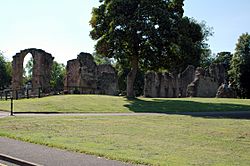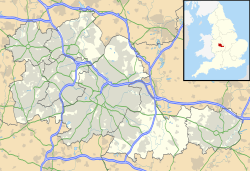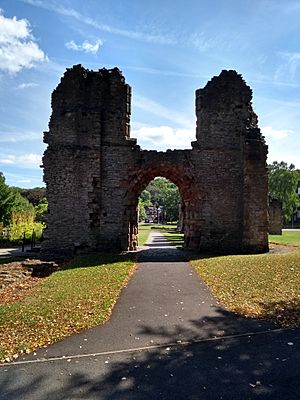Dudley Priory facts for kids

The ruins of Dudley Priory
|
|
| Monastery information | |
|---|---|
| Full name | Priory of Saint James |
| Order | Cluniac |
| Established | 1160 |
| Disestablished | c. 1530 |
| Dedicated to | St. James |
| Controlled churches | St. Michael, Cofton Hackett St. Edmund, Dudley St. Thomas, Dudley St. Laurence, Northfield All Saints', Sedgley |
| People | |
| Founder(s) | Gervase de Paganel, Lord of Dudley |
| Important associated figures | John Dudley, 1st Duke of Northumberland |
| Site | |
| Location | Dudley, West Midlands, England |
| Coordinates | 52°30′56″N 2°05′06″W / 52.5155°N 2.0851°W |
| Public access | Yes |
Dudley Priory is an ancient priory (a type of monastery) located in Dudley, West Midlands, England. Today, you can see its ruins within Priory Park. These ruins are very important. They are protected as a scheduled monument and a Grade I listed site. This special protection was given on September 14, 1949.
Discovering Dudley Priory's Past
The priory was started in 1160. It was founded by Gervase Paganel, who was the Lord of Dudley. He built it to honor his father's memory. The priory was part of the Cluniac order. This was a special group of monks. It was dedicated to Saint James. The priory was built using local limestone. This stone came from a nearby quarry called Wren's Nest.
The first known leader of the priory was named Osbert. He is mentioned in Gervase Paganel's original document. The priory owned several churches. These included the Church of St. Edmund and Church of St. Thomas in Dudley. It also owned churches in Sedgley and Northfield. There was also a chapel in Cofton Hackett.
Changes and Growth of the Priory
The priory grew bigger over time. One part that still stands is an archway. This archway led to the Lady chapel area. The Lady chapel was built in the 14th century. It was dedicated to the Virgin Mary. People believe the Sutton family helped build this chapel.
In 1395, the priory was closed for a short time. But it was reopened soon after.
The Priory's End and New Beginnings
The priory was finally closed in the 1530s. This happened during the time of King Henry VIII. He ordered the Dissolution of the Monasteries. This meant many monasteries across England were closed.
After it closed, the priory was given to Sir John Dudley, 1st Duke of Northumberland in 1540. Over the years, the buildings fell apart. They became the ruins we see today. In the 1700s, parts of the ruins were used for different jobs. People used them for tanning leather, making thread, and polishing steel. The area around the priory became very industrial.
In 1926, the local council bought the priory ruins. They also bought the land around it. Their plan was to build a new neighborhood. The priory ruins became part of the new Priory Park. This park served the new Priory Estate homes. These homes were built for people moving from crowded parts of town.
In 1939, an archaeologist named Rayleigh Radford worked at the site. He marked out where the old walls of rooms and cloisters were. He also found old medieval tiles. You can still see some of these tiles today.



